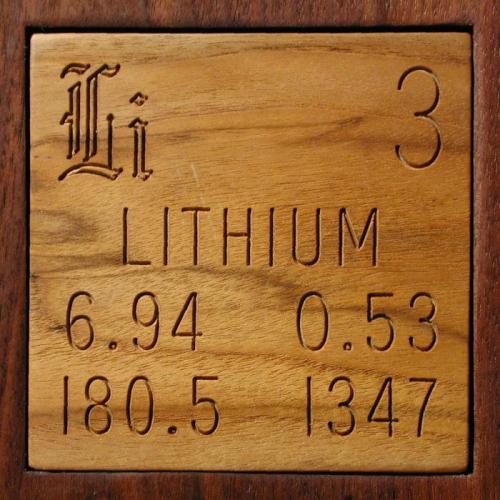  Lithium oxide crystals. Lithium oxide crystals.
If you had some thin lithium foil what would you do with it? I thought that maybe I could melt it into a lump, if I bathed the crucible in helium from a small balloon-filling tank (to prevent rapid oxidation) as I heated it from below. I was wrong.
Even with the helium shield gas, the lithium ignited almost immediately, and then proceeded to burn in much the same way lump magnesium does, only much faster (especially after I turned off the helium). This probably means I wasn't getting enough helium around the crucible, and some moist air was working its way in. Or maybe my helium, which just came from a disposable balloon filling tank, contained an oxygen impurity, which is not at all unlikely. Another possibility is that there was chemical contamination from the battery that permitted combustion.
(After seeing this, reader Walt Zarnoch sent the following: "I just read your page about melting lithium. You jarred my memory when you were talking about the possibility of oxygen impurities in the gas. I have heard that some of the suppliers of helium intended for store kits actually add oxygen intentionally, in small quantity, to the gas so that kids like me don't suffocate when inhaling helium from a balloon." So, that explains that. These days I have a large tank of argon for these purposes.)
I decided to change plans and just let a bigger piece of it (folded up tightly into a lump) burn itself out in the crucible. It lit instantly with a propane torch and burned quite dramatically, and very, very hotly. It actually cracked the tiny thimble-sized ceramic crucible I had it in. (Mind you, this is (was) a high-temperature ceramic crucible intended for burning and melting things in. It's not supposed to crack just because you make it hot.)
The explanation for this was kindly provided by reader Yehoshua Sivan from Israel, who wrote as follows:About 27 years ago I thought I would melt lithium in a ceramic crucible, and then suck it up into a glass tube (using a propipet, not my mouth!), to preserve a specimen, as I had already done with sodium and potassium [incidentally the specimens prepared then are as shiny today as when prepared originally; the oxide at the open ends of the tube acts as a plug preventing further oxidation, and the tube is kept in paraffin oil anyway]. Well, the lithium ignited, I beat a hasty retreat and watched the reaction through the crack in the door, and after some kind of explosion a piece of burning lithium fell on the brand new asbestos table (yes, they were still fitting asbestos tables then), where it also exploded, leaving a hole in the surface. I subsequently explained to my colleagues that now the table really looked as if it belonged to a chemistry laboratory.
I thought then, and I see no reason to think otherwise now, that this was a simple oxidation-reduction reaction, in which the lithium "steals" the oxygen from the silicon dioxide and other oxides in the ceramic (and in the asbestos). The reaction is analogous to the well known magnesium-sand reaction, or to the formation of a black silicon mark on test-tubes in which Mg or Na has been burned (e.g. in the classic magnesium burning in steam reaction, or when I burn sodium in a flow of chlorine). Sounds very familiar. This being a small world, I suppose it should come as no surprise to anyone that Yehoshua has been proof-reading the Hebrew translation of Uncle Tungsten, whose author Oliver Sacks recently came to visit me, and that Sacks' mother was Yehoshua's mother's family doctor. Nope, doesn't surprise me at all.
Yehoshua also pointed out two interesting articles about the great lithium fire of 1998, which occurred at a chemical waste dump in Israel: Article 1, article 2.
Source: Radio Shack
Contributor: Theodore Gray
Acquired: 12 August, 2002
Text Updated: 11 August, 2007
Price: $3
Size: 1"
Purity: <50%
|
| 
|
|